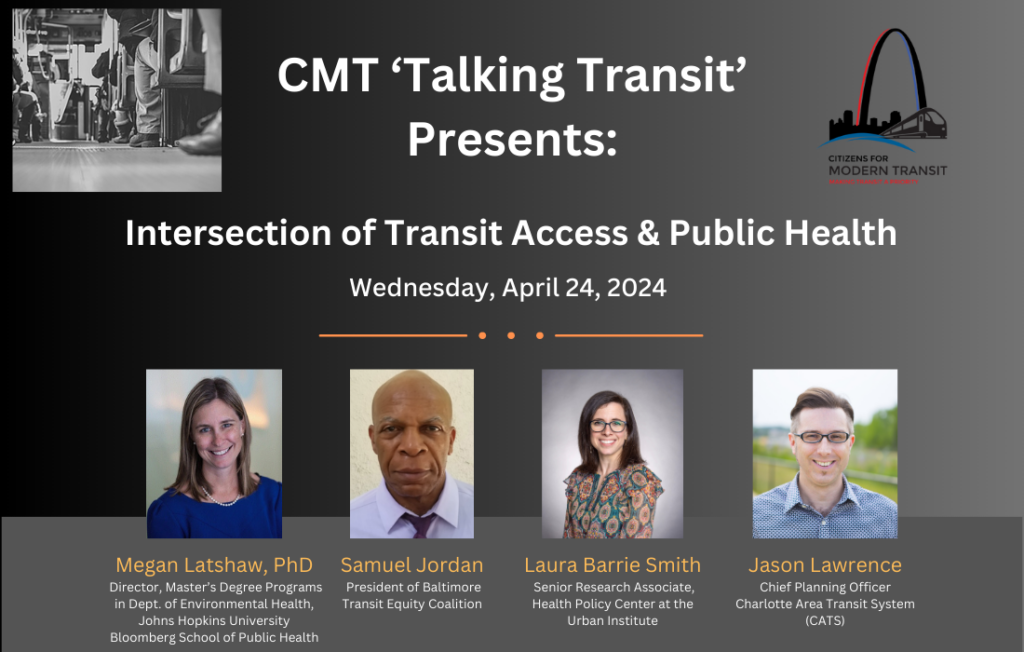Empirical Evidence Shows Expansion to a Public Transit System Improves Access to Health Care
As the St. Louis region continues to evaluate the proposed light rail expansion project, known as the Green Line, a closer look into health impacts of transit is crucial. Citizens for Modern Transit (CMT) therefore gathered transportation advocates and professionals, along with public health and urban planning researchers, to address the intersection between public health and access to transit during a recent “Talking Transit” event, hosted via Zoom on April 24. Dozens of CMT members, elected officials, stakeholders, transit riders and others attended the virtual forum and gained insights from data analysis and research findings specific to transit access and public health in Baltimore, Charlotte and Minneapolis. A key takeaway from this event is that empirical evidence shows access to transit improves community health. To view the discussion in its entirety, click here or view below:
The panel featured Megan Latshaw, Associate Teaching Professor at Johns Hopkins Bloomberg School of Public Health; Samuel Jordan, President of the Baltimore Transit Equity Coalition; Laura Barrie Smith, Senior Research Associate at the Urban Institute; and Jason Lawrence, Chief Transit Planning Officer at Charlotte Area Transit System. The discussion was moderated by Kimberly Cella, Executive Director of CMT.
Jordan and Latshaw set the stage by discussing the inequalities and disparities with respect to the racialization of public transit and the value of the completion of the Red Line light rail project in Baltimore and its significance for communities of color and households with modest incomes. They also showcased how the conversations around the Red Line project gave the city the opportunity to examine the intersectionality of transit with healthcare, education and employment and how that not only impacts transit riders, but non-rider residents of the region as well. Extensive research was shared from the 2021 Transit Equity & Environment Health in Baltimore City report, which was commissioned to help the city better understand the relationship between the public transit system, social vulnerability, air pollution, and health impacts in the Baltimore region. The report was a collaborative project between Johns Hopkins University, the Baltimore Transit Equity Coalition and Baltimore community members,
“Transit is a magic answer,” noted Latshaw. “It leads to development. It connects people to jobs, education, healthy foods and health care. You can kill so many birds with one stone. And through my role with Johns Hopkins, it is all about data, data, data for those people who may not be convinced of what is being said.”
Lawrence then shared how Charlotte’s transit system is working to move people with an integrated approach that supports transit-oriented development, placemaking, service expansion, the adaption of bus service to changing mobility landscapes, paratransit services and improved customer experience. This comes on the heels of data from a 2015 Harvard University Report that ranked the Charlotte region as last out of 50 major metropolitan areas in upward mobility. Many factors made up that ranking, however the report clearly identified access to reliable, convenient and frequent transit as a major determinant of an individual’s likelihood of achieving upward economic mobility. And, that travel time is the single strongest factor in a household’s odds of escaping poverty. Lawrence noted that to be a successful transit agency, it must plan and build more inclusive and thoughtful infrastructure, advance all layers of mobility, and that access to opportunity must be integrated into each transit project and service proposal.
Barrie Smith closed out the presentation with compelling insights from two studies by Urban Institute and the Robert Wood Johnson Foundation. The first looked at nationally representative data that documented the extent of transportation barriers to health care in the United States. Research found more than one in five adults with limited public transit access forgo health care because of transportation barriers. The second study looked at the impact of a new Green Line in Minneapolis. The study used econometric analysis to test whether the opening of the new line would lead to a decrease in no-shows to scheduled health care appointments. The study compared no-show rates before and after the line opened, for people living close to the new line compared to those not living close to the new line. Data showed a statistically significant decline in no-show visits after the Green Line opened for people living near the line compared to those not living near it. The effects were greatest for people with Medicaid health insurance (missed visits dropped by 8.6 percent), which primarily covers individuals with low incomes and serves a disproportionate share of people of color. Same-day visits also increased after light rail opened. The key takeaway from this study is that empirical evidence showed expansion of a public transit system improved access to health care. Fewer missed appointments likely means fewer delays in diagnosis and treatment of health conditions.
In closing, Smith stated, “Hopefully the work presented today and all the current and further research in this space can really demonstrate the positive impacts transit can have on access to health care and equity in health.”
CMT hosts quarterly “Talking Transit” events to keep members, transit riders and advocates, stakeholders, elected officials and others in the loop on issues and efforts influencing the region’s transit system. These educational gatherings feature expert guest speakers and panel discussions addressing a wide range of topics, including transit access, safety & security, transit-oriented development, best practices, service changes and more.
